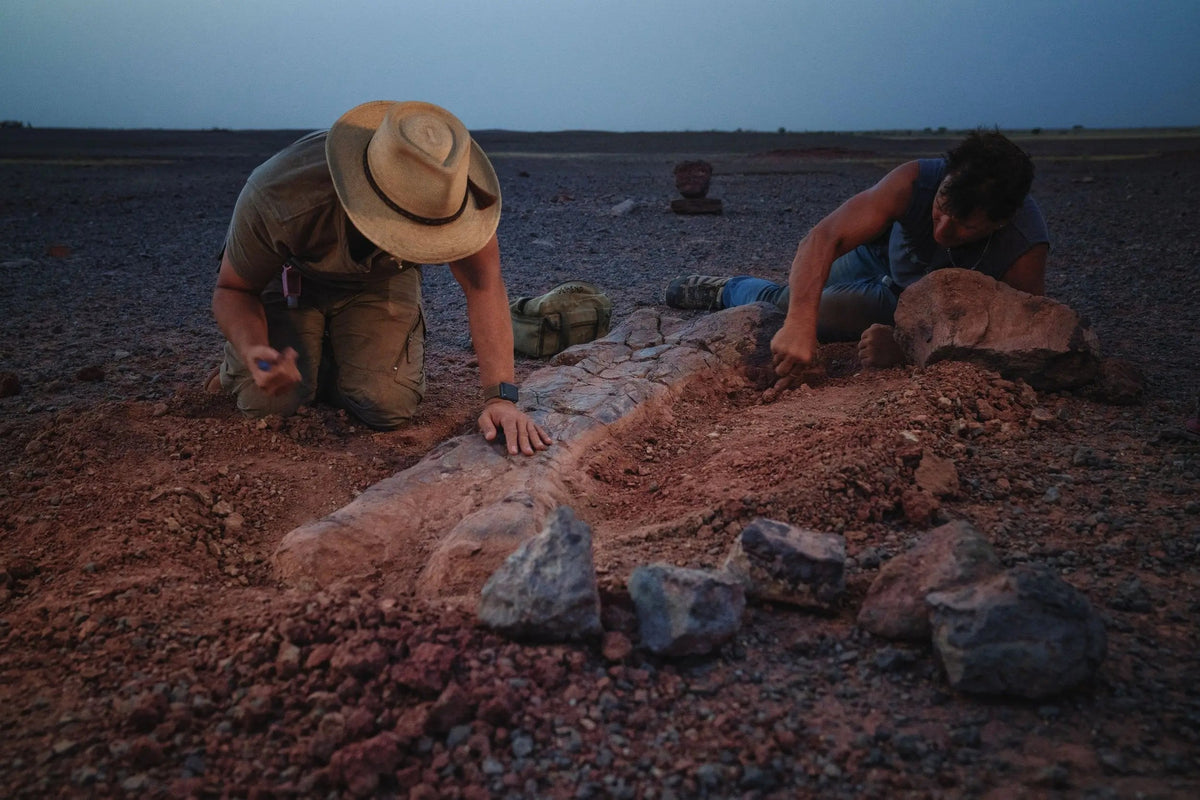

FOR IMMEDIATE RELEASE
August 9th, 2025 | Boulder, CO
Deep in the arid expanse of the Sahara Desert, an extraordinary scientific and cinematic expedition has brought ancient life back into focus. The National Geographic feature story “Sahara Desert Dinosaurs" a collaboration between a world-class paleontology team and a handpicked crew of photographers and filmmakers, chronicles the effort to uncover the remains of giant reptiles that roamed Africa nearly 100 million years ago.
(Feature based on 2022 expedition; published July 2025)
Led by renowned paleontologist Paul Sereno, the mission centered on remote fossil beds in Niger’s Ténéré Desert, a place Sereno has called “the graveyard of giants.” The article, published in National Geographic magazine in 2024, takes readers behind the scenes as scientists braved extreme heat, relentless sandstorms and logistical hurdles to excavate fossils from the Cretaceous Period, when the region was a lush river system teeming with life.
The photographic coverage of the story was spearheaded by National Geographic photographer Keith Ladzinski, whose still images capture both the stark beauty of the desert and the delicate precision of fossil excavation. Filmmaker Tommy Joyce served as director of photography for the digital video component of the project, creating motion sequences that brought the fieldwork and the creatures it sought to revive, vividly to life for an online audience.

Revisiting an Ancient Ecosystem in the Heart of Africa
While today’s Sahara is one of the driest places on Earth, 100 million years ago it was a wetland world of braided rivers, sprawling floodplains and lush vegetation. This Cretaceous landscape was home to some of the largest dinosaurs ever to walk the planet, including the long-necked Paralititan, the predatory Carcharodontosaurus and the sail-backed, semi-aquatic Spinosaurus.
In the story, Sereno and his multinational team, work meticulously to unearth fossilized remains preserved beneath meters of shifting sand. The work is painstaking. Each exposed bone must be carefully brushed clean, stabilized and jacketed in plaster for safe transport. The desert’s searing midday heat and unpredictable winds test both equipment and endurance.
For the visual team, the challenges were equally intense. “Shooting in that environment means working against sand intrusion on every lens, drone motor and tripod joint,” Joyce has shared in past interviews. “You adapt by moving fast, protecting your gear and accepting that the desert always leaves its mark on your work.”


Science, Storytelling, and the Digital Audience
The National Geographic coverage unfolded in both the print magazine and a complementary digital feature, expanding the reach of the expedition’s discoveries. Ladzinski’s still photography carried the weight of the magazine’s visual narrative, while Joyce’s video sequences allowed viewers to see the excavation process unfold in real time, the careful trowel work, the lifting of massive fossil jackets, the camaraderie and fatigue etched into the team’s faces at day’s end.
The digital story provided an immersive window into the logistics of remote field science. Viewers could see the convoy of vehicles crossing the barren desert, the open-air lab tents where bones were cataloged and the thrill of identifying a fossil in the field. It also conveyed the stakes, each recovered specimen is a piece of Africa’s deep evolutionary history, vulnerable to both natural erosion and illegal fossil trafficking.


The Human and Logistical Challenge
Transporting a scientific team, excavation gear and photographic equipment to one of the most remote corners of Niger requires precision planning. Permits must be secured, local logistics coordinated and supply lines maintained over hundreds of kilometers of sand tracks.
Once in the field, the pace is dictated by the desert itself. Sandstorms can halt all work for days, forcing the team to take shelter and protect both fossils and equipment. Water rations are carefully monitored and every extra kilogram in a vehicle must be justified.
For the film making team, these constraints shaped every creative decision. Drones could only be flown in low-wind windows. Lighting relied entirely on natural conditions, with sunrise and sunset providing the most cinematic opportunities. Camera batteries, drained faster by heat, had to be managed as carefully as the crew’s drinking water.
Conservation Beyond the Cretaceous
While the Sahara Desert Dinosaurs story is rooted in paleontology, it also connects to modern African conservation and heritage protection, a theme central to Joyce’s broader body of work. Fossil sites like those in the Ténéré are part of Niger’s cultural and scientific legacy and protecting them from looting or environmental damage requires local engagement.
The expedition partnered with local communities to hire guides, drivers and camp support, ensuring that the economic benefits of the project extended beyond the scientific team. This model mirrors the community-driven conservation approach Joyce has documented extensively in his African photography collections, from Kenya’s Maasai-led wildlife conservancies to Zambia’s tourism-supported anti-poaching patrols.


From Fieldwork to Fine Art
While the Sahara Desert Dinosaurs visuals were created for National Geographic, the ethos behind them aligns closely with Joyce’s fine art photography practice. His Africa Fine Art Photography Collections, which span Kenya, Zambia and Madagascar, share the same goal of preservation through storytelling.
The Power of Now
Africa’s natural history stretches far beyond living memory. By pairing scientific fieldwork with compelling visual storytelling, projects like Sahara Desert Dinosaurs connect audiences to that deeper timescale. They remind us that Africa has been, for millions of years, a cradle of life, from dinosaurs and crocodiles to elephants and lions.
For collectors, designers and art buyers, these narratives carry weight. A fine art print isn’t just decor, it’s a tangible connection to a place, a species, or a moment in time. Whether the subject is a modern lioness in Botswana or a fossilized predator from the Cretaceous, the common thread is Africa’s enduring capacity to inspire awe.
Looking Ahead
Following the publication of Sahara Desert Dinosaurs, Joyce has continued to expand his African work through both commercial assignments and self-directed expeditions. His role as Creative Director for ROAR AFRICA keeps him deeply engaged with the continent’s most iconic landscapes, while his print store provides collectors worldwide with access to limited-edition works from every major continent he has worked on.
From the sands of Niger to the glaciers of the Himalaya, Joyce’s commitment remains consistent: document with precision, share with integrity and create visual records that endure.
For those who encountered his work through the Sahara Desert Dinosaurs story, his Africa prints offer a way to bring a piece of that legacy home, a modern image from the same continent that once hosted some of Earth’s most astonishing creatures.

Expanding the African Narrative: Upcoming Safari Work
Looking ahead, Joyce’s connection to Africa will deepen further with upcoming expeditions to Botswana in partnership with ROAR AFRICA. Known for its pristine wilderness areas, Botswana is home to the Okavango Delta, a UNESCO World Heritage Site where seasonal floods transform the Kalahari sands into an intricate network of lagoons and channels teeming with wildlife. For Joyce, the Delta represents an unparalleled opportunity to merge fine art photography, conservation storytelling and luxury travel narratives.
The project will include photography and video of of Botswana’s most remote safari camps, each selected for its integration of sustainable tourism practices and commitment to supporting local communities.




